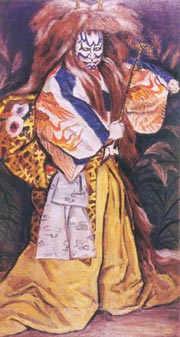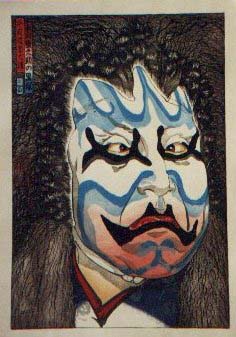| KUROZUKA |
| Play title | Kurozuka |
| Authors | Kimura Tomiko Kineya Sakichi IV (music) Hanayagi Jusuke II (choreography) |
| History |
The dance-drama "Kurozuka" was premiered in November 1939 at the Tôkyô Gekijô [casting]. The main role of the old woman, Iwate, was danced by Ichikawa Ennosuke II, later called Ichikawa En'ô I, and the dance was later included in the En'ô Jûshu, a collection of ten dances representing the best of En'ô's art. The story is based on the legend of the man-eating hag of Adachi-ga-Hara, and it also forms the basis for a Nô play entitled either "Adachi-ga-Hara" or "Kurozuka" (depending on the school of Nô). This Kabuki version, however, is a masterpiece of 20th century dance and includes many innovations in music and movement, some of which were inspired by the Russian ballet that En'ô saw while visiting London. |
| Key words |
Adachi-ga-Hara En'ô Jûshu Kurozuka Nagauta Shosagoto |
| Summary |
It is an autumn night on the wild moors of Adachi-ga-Hara and the sound of insects fills the air. In a clearing there is a tiny hovel, and on its reed blinds appears the silhouette of an old woman. Her name is Iwate. The opening lyrics describe the endless spinning of a reel of thread as, deep into the night, the woman waits hopelessly for someone's return. As though sensing something, she suddenly pauses, and the insects also stop. A group of travelling priests enters on a pilgrimage. They must find shelter for the night and, seeing the light from Iwate's room, they go to request lodgings. Though surprised to see such a fine group of priests in these lonely surroundings, she is impressed by their dignified appearance and consents. After explaining their purpose, the head priest Ajari Yûkei notices her spinning reel and asks for a demonstration. She shows them the workings of the humble device and sings a sad song to accompany herself. At this, Yûkei guesses that she was originally of noble birth and asks her to relate her life story. Iwate again agrees and we hear that as a young woman her father was banished to this distant place. She and her betrothed accompanied him here, but after some time her fiancé returned to the capital, abandoning her forever. Feelings of bitter hatred arose in her heart and she cursed the world. Yûkei assures her that all sins, no matter how grave, can be forgiven if the sinner calls on the saving grace of the Buddha, and Iwate is happy at the thought that even she can gain salvation. Desiring to be hospitable, Iwate says she will go to a nearby mountain to collect firewood for her guests. She warns them repeatedly, however, that they are not to look inside her room while she is gone. The priests are accompanied by a mischievous porter named Tarôgo. Told not to look inside the room, he wants to look all the more and, while the priests are at their prayers, he sneaks behind them to take a peek. Within the room he sees a mountain of bones and half-devoured limbs. They realize at last that the old woman is none other than the infamous demon of Adachi-ga-Hara who preys on passing travellers. The next scene is the central dance section and an undisputed masterpiece. The music is given an unusual touch by the inclusion of the zither-like koto, not normally heard on the Kabuki stage. A little time later on the wild moors, Iwate is returning with the firewood. Yûkei's words have lightened her heart for she believes that, despite her sins, she can still attain enlightenment. Beneath a large crescent moon she playfully chases her own shadow and, regaining the lost innocence of childhood, she sings a children's song to the moon. The lyrics describe the wind blowing with the sound of a flute over the pampas grasses so that even the leaves are forced to dance. After so many long years Iwate is at last filled with hope. Just then, however, Tarôgo comes running in a panic. Unthinkingly, he bumps into Iwate who immediately realizes by his changed complexion that he has disobeyed her words. Believing herself betrayed by humanity yet again, Iwate is overcome with violent rage. Bitter at the fact that even the saintly priests have proved false, her hatred changes her instantly into a demon and she disappears into the night. For the last scene, a large mound of earth rises on the central stage lift representing the demon's lair. Having seen for themselves that the porter was right, the priests resolve to put their years of ascetic training to the test and come in search of the demon. The black mound breaks open and the demon appears in all her hideous disfigurement. There is a fierce battle during which the priests pray with all their might, gradually sapping Iwate of her strength. In a departure from traditional Kabuki demons that, even when defeated by the forces of good are not usually seen to be weakened, this portrayal clearly reveals the psychological struggle raging inside Iwate's mind, torn as she is between hatred for humanity and the guilt and shame at her own sinful nature. Courtesy of Paul M. Griffith |
 |
 |
|
Ichikawa Ennosuke II playing the main role of the dance-drama "Kurozuka" (oil painting made by Hasegawa Noboru in 1958) |
Ichikawa Ennosuke III playing the role of the old woman Iwate, in reality an ogress, in the dance-drama "Kurozuka" |
|
|
| Contact | Main | Top | Updates | Actors | Plays | Playwrights | Programs | Links | FAQ | Glossary | Chronology | Illustrations | Prints | Characters | Derivatives | Theaters | Coming soon | News |